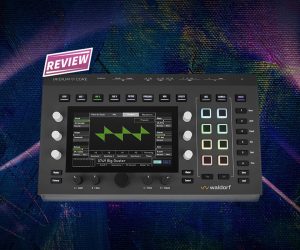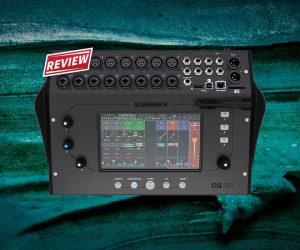
Review: Prism Sound Titan Audio Interface
Titan is part of a whole new breed of Prism Sound interfaces that will convert you to high quality sound.
Prism Sound is a benchmark for digital audio recording and playback. There’ll be no argument there. For years the company released industrial strength A to D and D to A converters which kept the bar at prodigious heights. Like all best-in-class technology, however, Prism Sound converters were always far too expensive for the aspiring recording enthusiast. Thankfully the cost of Prism Sound’s technology has lowered appreciably in recent years, with the company’s initial foray into ‘affordable’ converters being the Orpheus back in 2008. While still a top-shelf set of converters with an equally top-shelf asking price, the Orpheus was streets more affordable than the Dream series of converters the company rose to prominence with — those units will set you back a staggering $13,000.
Now you’re back in your chair you’ll be refreshed to learn Prism Sound’s latest offering doesn’t come near those price figures, although it certainly isn’t a budget interface. The Titan is a continuation of Prism Sound’s USB-based interfaces reviewed a couple of issues back such as the Lyra and the Lyra 2. However, connectivity with the Titan is more than mere USB, and includes some versatile options for connecting to various systems. Pricing is described as ‘accessible’, which is a fair assessment considering the Prism Sound pedigree, and especially when compared with Prism’s high-falutin’, and for most, inaccessible Dream ADA-8XR.
USED ANYWHERE
In use the Titan arcs up immediately. No install issues at all. Connection is via USB 2. Yep! All this I/O is shunted to your laptop or desktop CPU via the truly universal serial bus. I had no trouble whatsoever recording 18 tracks at 44.1k to a machine running OS X 10.8.4 with a 3.2GHz i5 processor. 14 tracks went down happily at 96k, and 10 tracks at 192k. The Titan swallowed it all whole at a buffer size of 128 samples. Speaking of platforms, Windows (Vista, 7 and 8, 32- and 64-bit, ASIO and WDM drivers), as well as OS X 10.4.11 and later (Intel) are all supported. Once configured with a computer, Titan can also operate as a stand-alone unit using analogue, ADAT, S/PDIF or AES/EBU I/O. I must say, until recently I’d never expected USB 2 (and 3) audio interfaces to be this bulletproof, but it appears the slow demise of Firewire has increased manufacturers’ development processes toward this ubiquitous bus system. That said, the MDIO slot could be fitted with a Thunderbolt interface option, eradicating bottleneck concerns pretty much completely.
Equally versatile is the unit’s ability to have I/O mixed and routed allowing low-latency mixes to be bused to any of the unit’s outputs, including the digital outputs and headphone outputs. This abundance of functionality is accessed via a software control panel that appears to work flawlessly upon first install. As you can see, this is a professional recordists’ piece of interfacing, covering every possible function you could reasonably expect, and unlike many ‘pro’ interfaces, most functions are available across all analogue inputs — for example, the high-pass filters and phase reversal included on the TRS inputs should your outboard preamps not include these features. Considerate indeed.
NEED TO KNOW

QUEEN OF CONVERSION
Oh yes indeedy, this is a quality piece of work. The Titan is an interface to keep the most demanding recordist huffing upon their knuckles as they tackle a multitude of live and tracking style projects with ease and finesse. Not only does the recording and reproduction quality bear this out, but also the vast array of professional options. Obviously clock and jitter are important issues to consider with an interface of this ilk, and Prism Sound goes to great lengths to outline the technology behind its clocking technology in the unusually well presented and informative manual, along with explanations behind the various dithering algorithms included in the unit. Really, the feature list keeps on rolling with the Titan.
For those who get a kick out of comparing specs, true to form, Prism Sound actually publish comprehensive specifications, while so many other manufacturers aren’t game to follow suit. This in itself is a testament to the quality and conviction behind both Prism’s products and ethics — three resounding cheers. The Titan’s analogue outputs provide a dynamic range of 115dB and an impeccable THD figure of 0.00045%. That’s a seriously low distortion figure. Frequency response is well documented; with the high definition sample rates such as 96k and 192k rolling off a mere 0.05dB at 32kHz and 3dB at 47.8 and 76kHz respectively. For garden variety 44.1k and 48k rates, rolloff of 0.5dB occurs at 21.4 and 23.2kHz — damn close to the theoretical limits of each format.
Now while on the subject of specs, it’s interesting to note the published specs of the Titan are pretty close to the published specs of the Benchmark DAC1 I use for regular monitoring. Sure the Benchmark is getting rather long in the tooth but spec-wise they’re alarmingly similar. That established, specs are evidently not the be-all and end-all as an audition comparison between these units bears out quite clearly. In other words; the Titan creamed the Benchmark. There’s much more depth to the stereo image, bottom end is far more present and ‘authoritative’, and high frequency reproduction is smooth and blissful. The Titan is an absolute joy to listen to, and those mic preamps? They’re sublimely top-notch recording channels.
Also top notch is the ‘Overkiller’ circuit on each of the inputs, which can be individually instigated on each channel. This is basically an extremely fast progressive limiter which will buffer peaks to a degree of about 10dB. LED indicators on the front panel let you know when the Overkillers are actually limiting.
Would I own a Titan? You can bet your bum I would. Yet while the Titan is still up there price-wise, it’s very competitive when compared to flagship units from other premier interface manufacturers. What sets the Titan apart from many other units is its extreme versatility — with a remit ranging from small on-site ensemble recordings through to acting as the main interface in bespoke recording environments. In short, a stunning piece of machinery for the recording perfectionist.
















RESPONSES